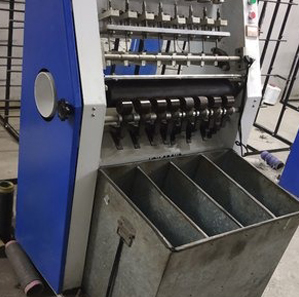

Another type of braiding machine to produce two-dimensional braids is the rotary machine. The rotary braiding machine is faster than the maypole braider. However, rotary machines are less versatile in terms of making different shapes and they have less number of carriers.
Flat braiding-mechanism
Flat braids are made in the form of flat strips or tape. In flat braiding, instead of following two continuous paths, the carriers turn around or
reverse direction at two points called terminals and then continue on the other direction, i.e., the track does not complete a circle.
The size of the braid is governed by the following factors:
The number of carriers: tubular braiders have even number of carriers, and flat braiders usually have odd numbers of carriers. The minimum number of carriers is three, which gives the basic diamond braid similar to the girl’s plaited hair.
The diameter of the yarn.
The number of yarn ends per carrier.
The number of yarns per unit length.
Take-up speed: Since the speed of the carrier is constant, the openness of the fabric is changed by changing the take-up speed of the fabric.
3-D braiding
3-D braiding is an interesting concept of creating a two dimensional array of interconnected 2-D circular braids. 3-D braids are formed on two basic types of machines. These are the horn gear and cartesian machines which differ only in their method of yarn carrier displacement. While the horn gear type machines offer improved braid speed over the cartesian machines, the cartesian machines offer compact machine size, comparatively low development cost and braid architectural versatility.
Horn gear braiding process
Horn gear machines with square or circular arrangement are employed in the fabrication of solid braids. Present-day machines are limited to 24 yarn carriers and therefore limit the size and shape of perform. The micro-geometry of braid is also restricted. The braider yarns form is intertwined helical paths through out the structure.
Cartesian braiding process
The basic Cartesian process involves four distinct Cartesian motions of groups of yarns termed rows and columns. For a given step, alternate rows (or columns) are shifted a prescribed distance relative to each other. The next step involves the alternate shifting sequence of the first and second steps, respectively. A complete set of four steps is called a machine cycle. It should be noted that after one machine cycle the rows and columns are returned to their original positions.
Braids
A braid is a rope like thing, which is made by interweaving three or more strands, strips, or lengths, in a diagonally overlapping pattern. They are used for various industrial applications. Made of different kinds of materials, such as cotton, polyester, nylon, plastic strands, etc, braids can be made in different thickness, lengths, etc. Primarily there are two kinds of braids.
Round Braids: Round braids have a round or oval cross section. The products made are cords (technique), laces (for clothes), cables (electro technique) or ropes (heavy braids).
Flat Braids: Flat braids are called laces or just flat braids. Braids have special characteristic features. Standard braids have only a low lateral stability. Due to this property they can be sewn to other textiles without problems. On the other hand they can be made rigid and stiff with inserts and after treatment. The load-bearing capacity of braided products is much higher as of products made with other techniques.
Geometry
The width L is called a line and the length S is called a stitch or pick. W is the width of yarn from which the braid is made. Braid structures are specified by the
line and stitch numbers. α is the braid angle, which specifies the angle by which the yarns lay from direction of machine axis. Braid angle is determined from the relation between the take-up speed and carrier speed.
Modern braiding machines
Fast knit braiding machine Main features:
Output: 2 cords.
Yarn packages can be directly used.
Any diameter from 2 mm to 12 mm can be produced on same machine.
Construction of cords 4, 6, 8, 12 bobbins is possible on same machine.
Density (picks/cm) in produced cord is adjustable in running of machine.
Space saving, high speed and still quite in running.
Power – 3 ph, Electric Motor – O.S.HP.
MODEL SM-6
Main features:
Output 6: Cords.
Diameter: 2 to 6 mm.
Construction of cords: 4 or 6 ends.
Other features similar to COMBI.
Extra attachments:
Heat setting device.
Rubber feeder for round elastic cords.
Regulator for round elastic cords.

